Bio-based composites of sago starch and natural rubber reinforced with nanoclays
Vol. 17., No.11., Pages 1096-1109, 2023
DOI: 10.3144/expresspolymlett.2023.83
DOI: 10.3144/expresspolymlett.2023.83
GRAPHICAL ABSTRACT
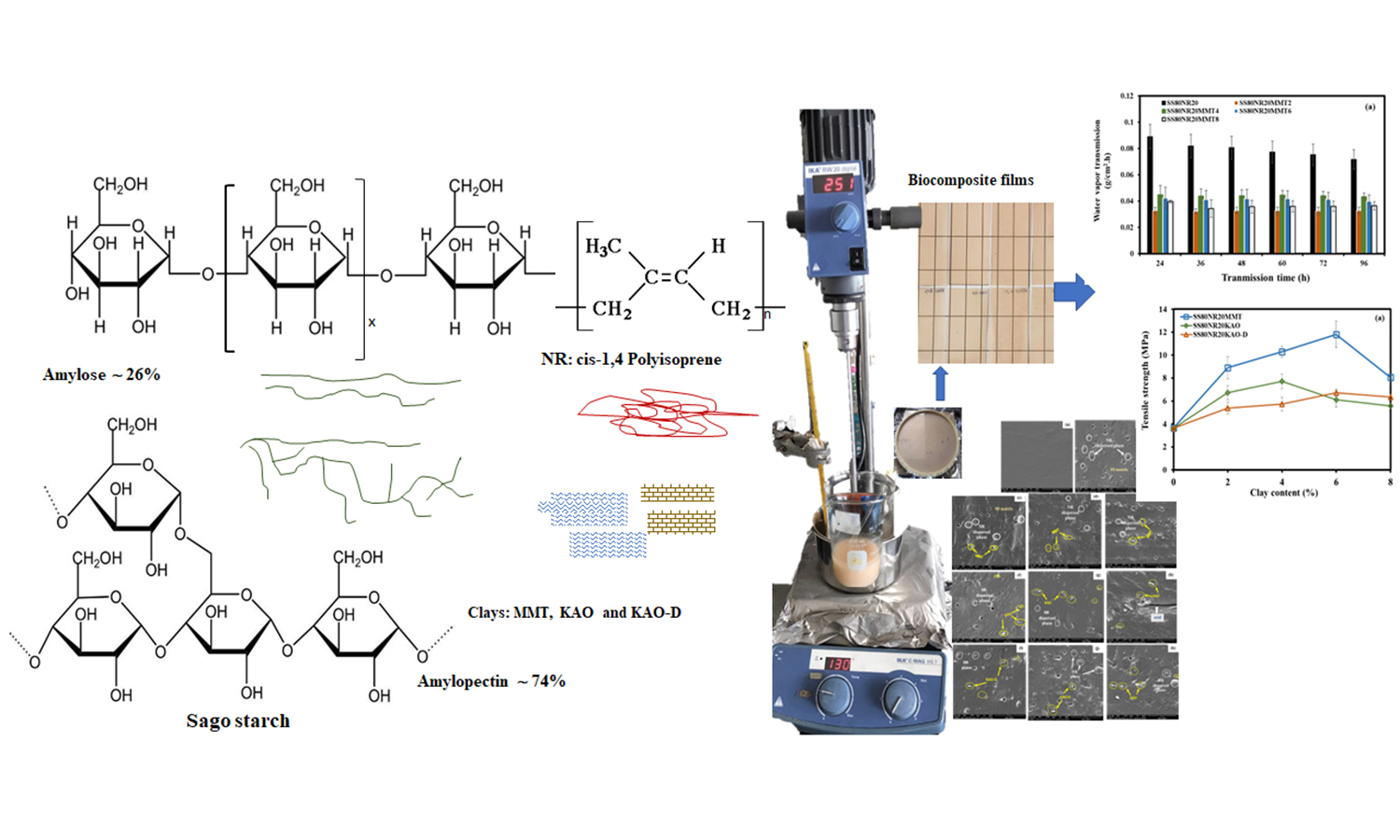
ABSTRACT
Sago
starch (SS) was blended with natural rubber (NR) using nanoclays, namely
montmorillonite (MMT), kaolinite (KAO), and kaolinite modified by dimethyl
sulfoxide (KAO-D) to enhance its physical and mechanical properties. Each nanoclay
was incorporated at 2, 4, 6, and 8 wt%, respectively. The SS80NR20 (80 wt% of
sago starch and 20 wt% of natural rubber) biocomposites were characterized by
solubility of water, water vapor transmission, mechanical and thermal
properties. The constituent interaction and morphology of the SS80NR20
biocomposites were also presented by using X-ray diffraction (XRD) technique
and scanning electron microscope (SEM). The findings demonstrated that the
inclusion of clays significantly improved both the water resistance and tensile
properties when compared to the SS80NR20 blend. In the SS80NR20 biocomposites,
MMT at 6 wt% exhibited the lowest moisture content, solubility in water, and
water vapor transmission. As the amount of nanoclay in the biocomposites
increased, their tensile strength dramatically increased whilst their strain at
break had a tendency to diminish. Strong interaction by establishing the
intercalated structure of MMT, and KAO within SS80NR20 biocomposites were
attributed to both physical and mechanical properties, while the weak
interaction at the interface of SS and NR was attributed to KAO-D.
RELATED ARTICLES
Konrad Stefaniak, Anna Masek
Vol. 19., No.4., Pages 386-408, 2025
DOI: 10.3144/expresspolymlett.2025.29
Vol. 19., No.4., Pages 386-408, 2025
DOI: 10.3144/expresspolymlett.2025.29
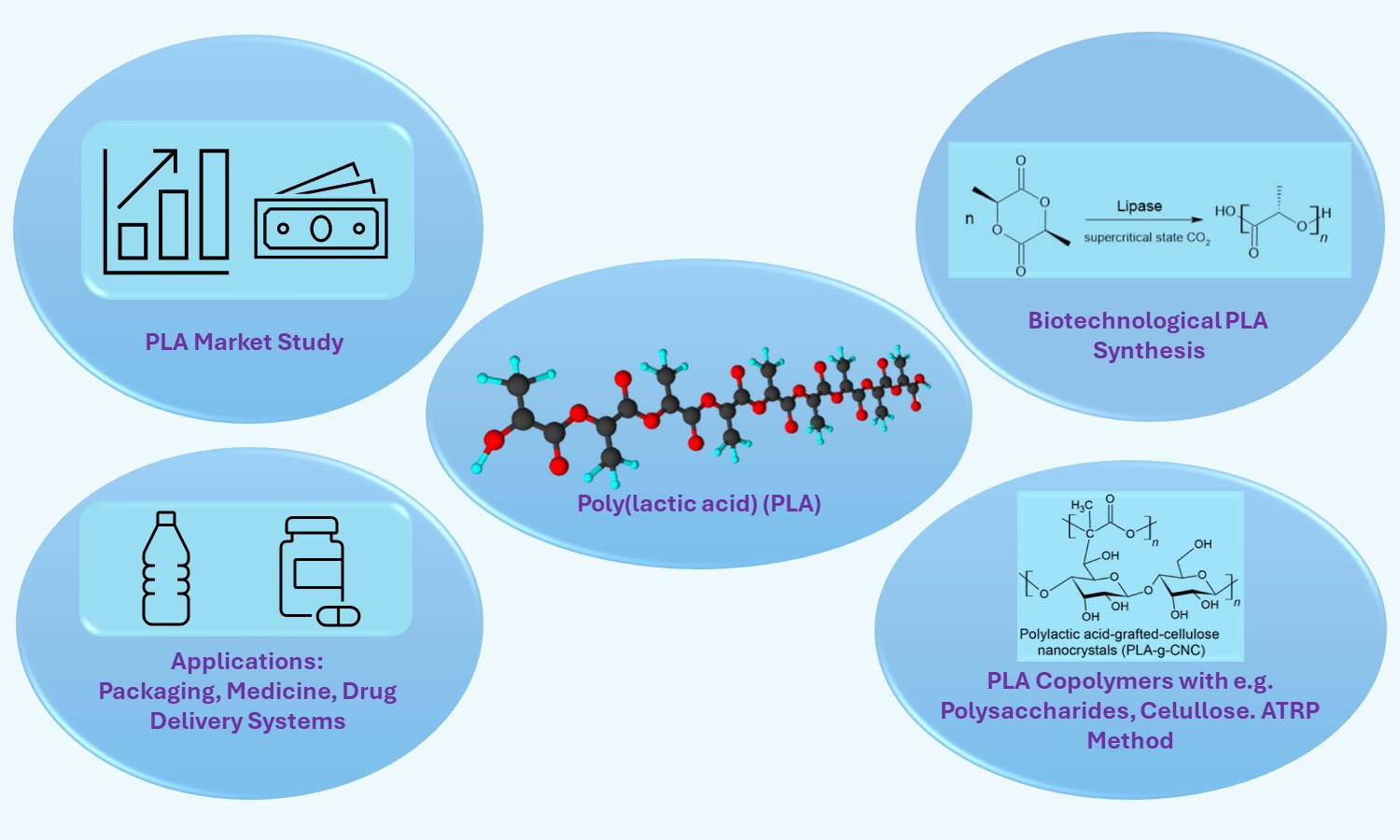
This review is focused on recent achievements in poly(lactic acid) (PLA) synthesis and copolymerization with special regard to biotechnological routes of PLA synthesis, which use bacteria/enzymes (e.g., enzymatic ring opening polymerization (eROP)). Besides PLA, also lactic acid (LA) synthesis is described and an emphasis is put on the biotechnological methods. Having regard to PLA copolymerization, this paper attempts to describe different types of PLA copolymers (such as block copolymers, PLA copolymers with polysaccharides, PLA-cellulose copolymer composites, and PLA polymer brushes). A detailed overview of the recent accomplishments in the field of PLA copolymers is presented. Various enhanced properties and applications of presented PLA copolymers are discussed. The attention is placed mainly on applications in the field of tissue engineering, drug delivery systems, and the packaging sector. Furthermore, a PLA market study and its economic forecast are presented. Eventually possible directions for future research in the field of PLA synthesis and copolymerization are indicated.
Rattanawadee Hedthong, Thorsak Kittikorn, Suding Kadea, Phuthanet Bamrungsiri
Vol. 19., No.4., Pages 423-440, 2025
DOI: 10.3144/expresspolymlett.2025.31
Vol. 19., No.4., Pages 423-440, 2025
DOI: 10.3144/expresspolymlett.2025.31

This research aimed to enhance the properties of poly(3-hydroxybutyrate-co-3-hydroxyvalerate) (PHBV) biocomposites by incorporating hemp microcrystalline cellulose (MCC). Additionally, to improve interfacial adhesion between PHBV and MCC phases, a compatibilizer consisting of epoxidized natural rubber (ENR) grafted with microfibrillated cellulose (MFC) modified by vinyltrimethoxysilane (ENR-vinyl silanized MFC) was introduced. The addition of 5 wt% MCC increases the flexural modulus by approximately 65%. The use of ENR-vinyl silanized MFC as a compatibilizer demonstrated improved compatibility, as observed in scanning electron microscope (SEM) images. After 30 days of accelerated weathering (QUV) exposure, the flexural strength of the PHBV-based biocomposite with ENR-vinyl silanized MFC and MCC (vinyl silanized MFC biocomposite) was superior to that of the other samples. The remaining flexural strength can be sequentially categorized as follows: vinyl silanized MFC > MFC > non-MFC > PHBV. The Tg of PHBV-based biocomposites showed no significant change. Interestingly, the crystallinity of the vinyl silanized MFC biocomposite was the highest among all materials and demonstrated higher hydrophobicity. This makes the vinyl silanized MFC biocomposite a suitable material for construction, furniture, and both exterior and interior decoration.
Ju Li, Lize Yang, Shuo Chen, Guotao Sun
Vol. 19., No.1., Pages 47-59, 2025
DOI: 10.3144/expresspolymlett.2025.4
Vol. 19., No.1., Pages 47-59, 2025
DOI: 10.3144/expresspolymlett.2025.4
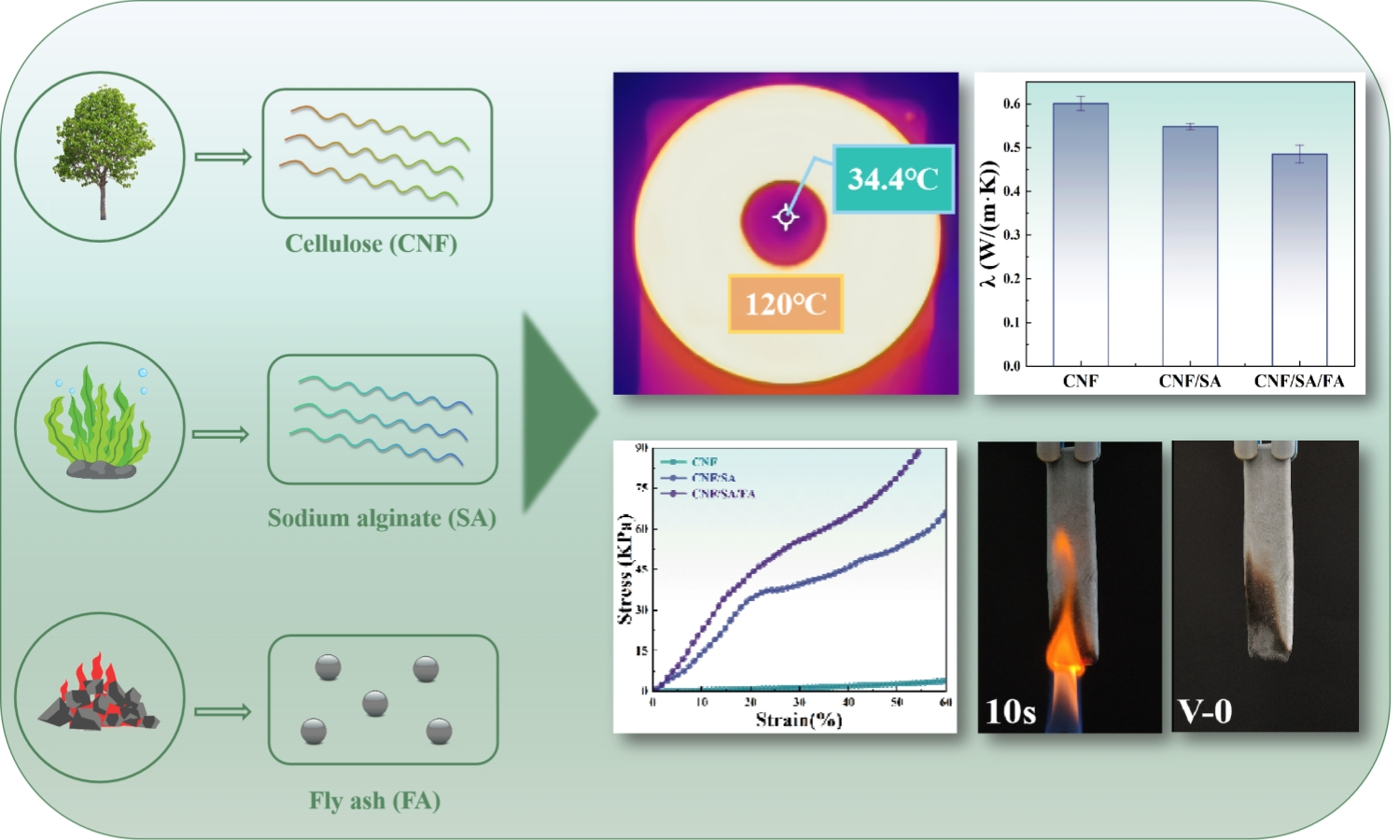
The widespread use of cellulose nanofiber (CNF)-based aerogels is hindered by their limited flame retardancy and mechanical properties. This study addresses these challenges by developing cellulose nanofiber/sodium alginate/fly ash (CNF/SA/FA) aerogel through a one-pot method, utilizing industrial waste fly ash (FA) as a reinforcing material. Various characterization and analytical techniques were employed to evaluate the properties of the CNF/SA/FA aerogel. The findings have revealed that resulting aerogel exhibited excellent thermal insulation performance, with a thermal conductivity of 0.485 W/(m·K), along with an impressive compressive strength of 88.4 kPa and favorable shape processability. Vertical combustion tests demonstrated a V-0 rating, indicating superior flame retardancy, and the aerogel achieved a remarkable 79.16% residual carbon, confirming their effective heat shielding capabilities. Notably, the incorporation of FA significantly enhanced both the thermal and mechanical properties of the composite aerogel, presenting a sustainable and effective solution to optimizing the properties of aerogel for thermal insulation.
Milanta Tom, Sabu Thomas, Bastien Seantier, Yves Grohens, Mohamed Pulikaparambil Kochaidrew, Ramakrishnan Subramanian, Tapas Ranjan Mohanty, Henri Vahabi, Hanna Joseph Maria, Jibin Keloth Paduvilan, Martin George Thomas
Vol. 18., No.6., Pages 638-655, 2024
DOI: 10.3144/expresspolymlett.2024.47
Vol. 18., No.6., Pages 638-655, 2024
DOI: 10.3144/expresspolymlett.2024.47
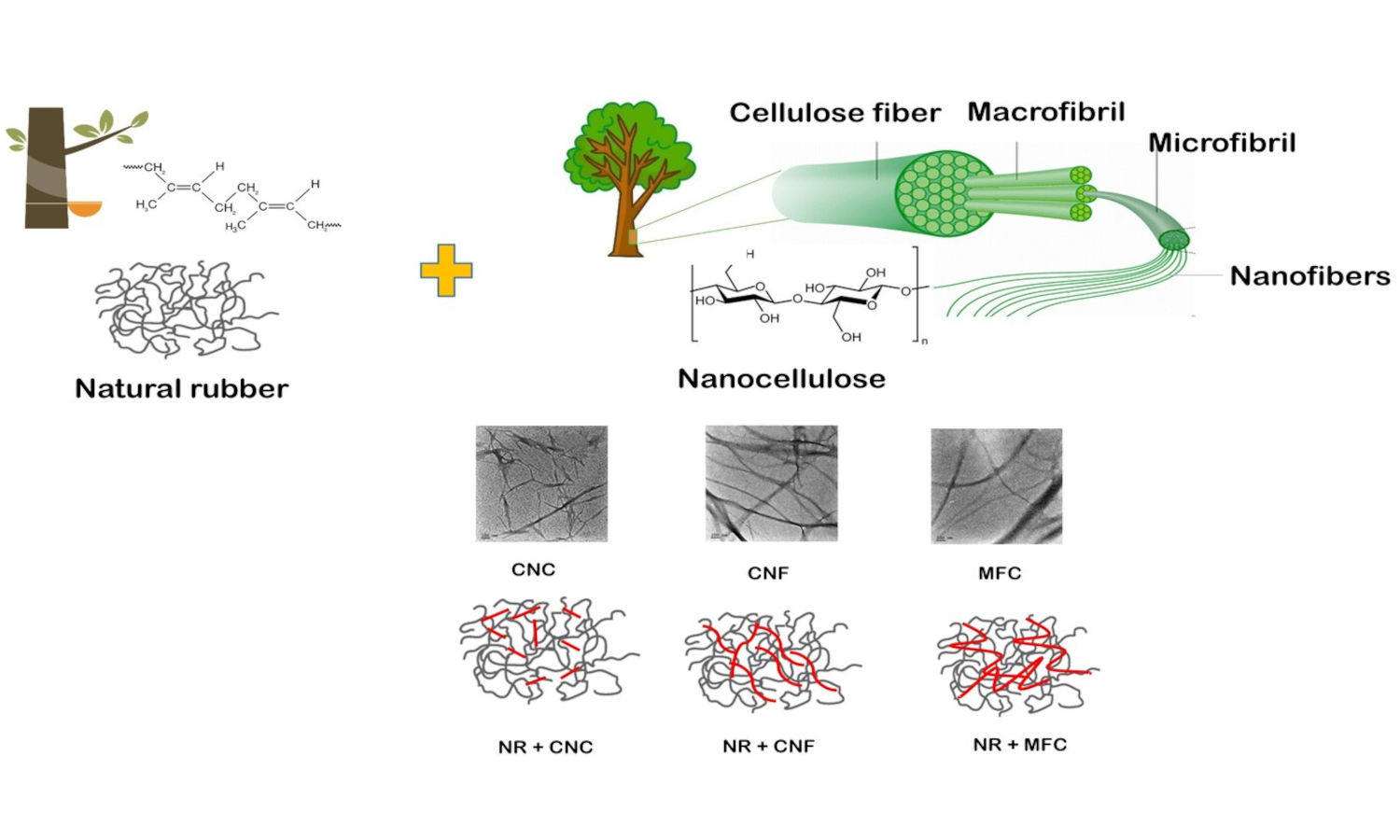
The augmented demand for
sustainable nanocomposites has paved the way to explore naturally derived
materials. Nanocellulose, with its bountiful sources and inherent properties,
ranks top in the list of biofillers with a perspective of reducing the carbon
footprint. A systematic study is required to understand the reinforcing effect
of various types of nanocellulose. In the present work, we selected three types
of nanocellulose, i.e.,
cellulose nanocrystal (CNC), cellulose nanofiber (CNF) and microfibrillated
cellulose (MFC), to investigate the effect of geometrical structure on the
properties of unvulcanized natural rubber (NR). Incorporating these fillers
improved the tensile strength and modulus of natural rubber films significantly
through reinforcement via filler network structure. The reinforcing effect of
CNF was found to be higher compared to CNC and MFC, where an increase of 3.85
MPa in tensile strength from the neat sample was obtained. More uniform
dispersion was evident through transmission electron microscopy, atomic force
microscopy and Raman imaging for CNF in the rubber matrix. The structural
properties were determined using Raman spectra and X-ray diffraction. The rheological
studies revealed a good interaction between filler and NR. The work presented
comprehensively compares different types of nanocellulose as reinforcing filler
in NR matrix, which will help the researchers select an ideal type for their
specific application and, thus, the proper usage of renewable resources,
leading to sustainability and a circular economy.
Fatma Nur Parın, Hatice Dinç, Uğur Parın, Elife Kıldalı, Gökçe Taner
Vol. 18., No.3., Pages 282-295, 2024
DOI: 10.3144/expresspolymlett.2024.20
Vol. 18., No.3., Pages 282-295, 2024
DOI: 10.3144/expresspolymlett.2024.20
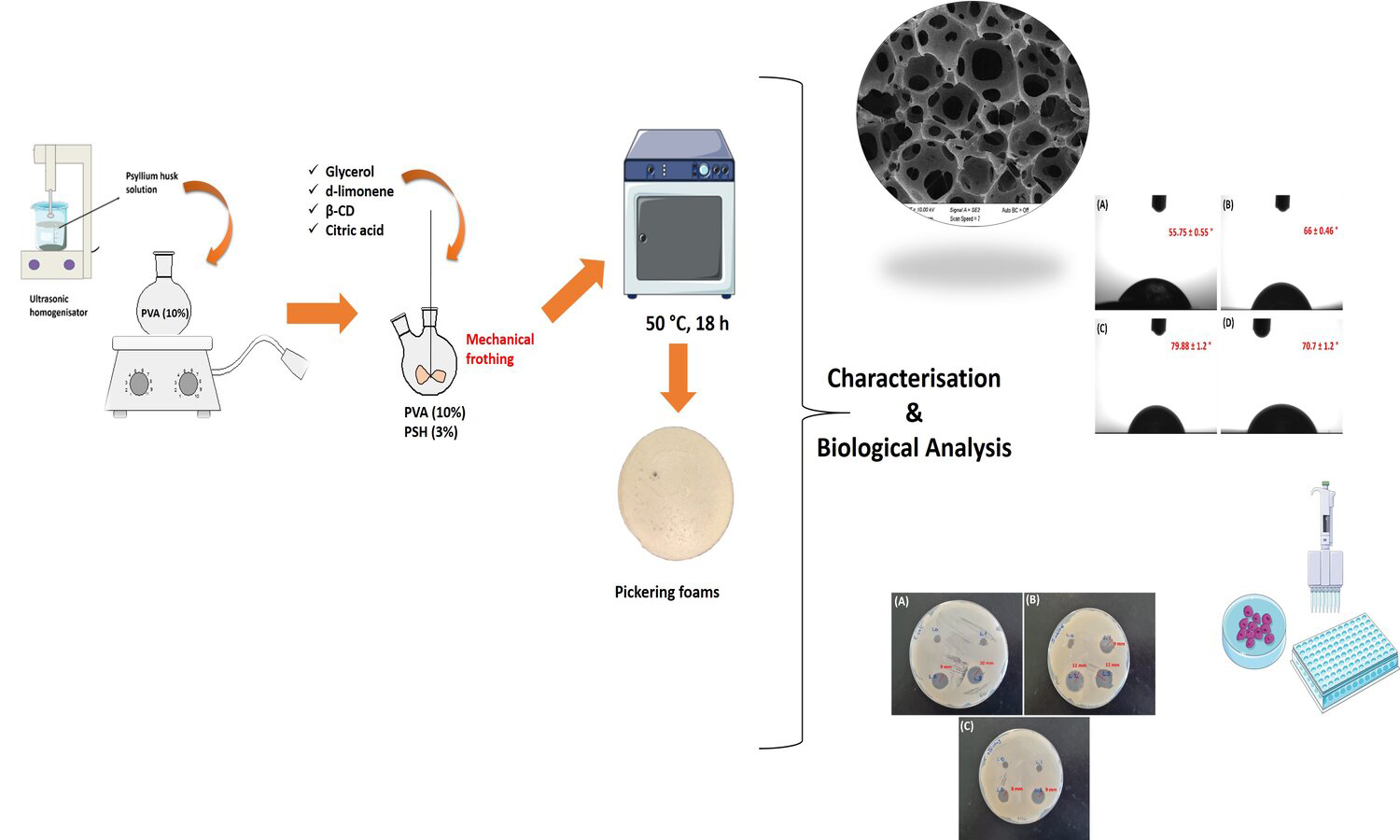
In this study, Pickering foamed emulsions have been prepared using β-cyclodextrin (β-CD), and d-limonene as a surfactant and an oil phase, respectively. The incorporation of β-CD/d-limonene inclusion complexes (ICs) in specific proportions (1:1, 1:3, and 1:5) to water phase, which is a polymer matrix composed of a mixture of polyvinyl alcohol (PVA) and psyllium husk (PSH) by mechanical frothing at high speed, and air bubbles have been formed in oil in water (o/w) emulsions. Ecofriendly bio-based foams have been developed in this method. Scanning Electron Microscope (SEM) analysis showed PVA/PSH Pickering foams usually open porous morphologies and the addition of d-limonene increases the amount of porosity from 43 to 49%. Although the resulting foams indicated similar thermal degradation profile, the presence of d-limonene in foams increased thermal stability. The surfaces of foams have a hydrophilic property with contact angles values lower than 80°. The tensile strength of foams decreased from 170 to 100 kPa due to the increased porosity. All foams indicated antibacterial activity to Staphylococcus aureus (S. aureus) with 9–12 mm zone inhibition. The incorporation of d-limonene into foams surprisingly decreased the cell viability. In brief, our findings show that the Pickering foams can be beneficial for wound healing applications.




